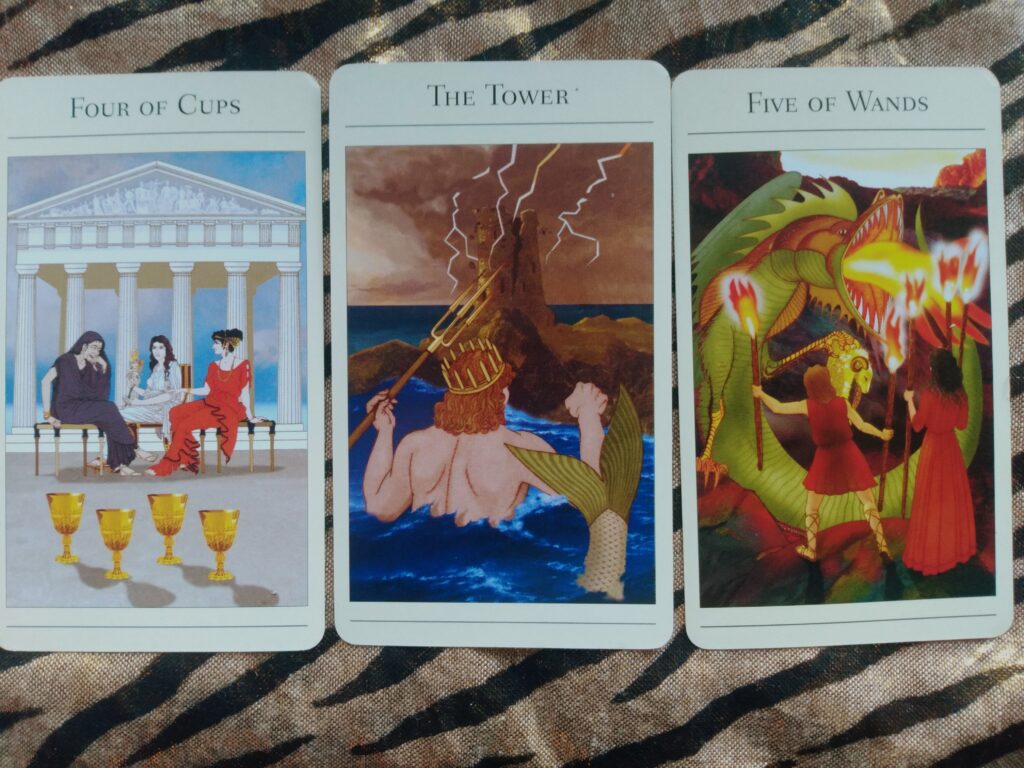While adjusting to incoming changes, it is essential to learn the difficult practice of “letting go.” When we set our goals, there is no guarantee that things will go according to plan. Disruptions and adjustment are a part of life that can be difficult, disappointing and scary. In this pensive time of reflection and shifting priorities, I ask my spread: “How do we know when to let go?”

This week’s tarot spread begins with The Four of Cups, followed by The Tower, and ends with The Five of Wands. In The Four of Cups, we encounter a young Psyche, sitting between two sisters who whisper doubts to the new bride about her groom Eros. The Tower, which signifies power given by Poseidon to Minos, is seen being struck by lightning as the god Poseidon emerges from the ocean floor. Our last card, The Five of Wands, shows a determined Jason battling with a dragon in order to win the Golden Fleece and reclaim his rightful place as king. Strong narratives indeed!
The first card in our spread, the Four of Cups, may be recognizable to some previous readers as we once again meet a discontented Psyche. Psyche has just become a new bride to her love, Eros (aka Cupid). Unbeknownst to both her and her sisters, however, Eros is more than just a man. He visits his wife nightly, but he does not spend time with her during the day. Psyche loves Eros but is not content with the current state of her marriage. As we see in the Four of Cups, Psyche has a look of concern and is seated between two of her sisters, both of whom are whispering in the maiden’s ears. Their discussion revolves around Psyche’s disposition and fuels a flurry of doubt around Eros’ identity and integrity. Psyche festers in this doubt and, in desperation to know the truth of her husband, unveils the covering over his face in his sleep and reveals his true identity as a god, which causes her to lose Eros’ trust. The strongest theme in this card is that of doubt and the road it can lead us down. Psyche is already struggling to believe in her husband. Combined with the doubt of her sisters, desperation and fear take over Psyche, leading her to her state of fear of mistrust. Doubt can feel like logic, protection and caution, but it is also the result of unhappiness, discomfort and insecurity. This card challenges us to look beyond our doubts to their root causes so that we may attain confidence in our authenticity.
The Tower exemplifies this need to cast aside doubt by standing both as an obstacle and as a great beacon of hope. Though it is a rough road, and we may have to face down shame, we will eventually be free from doubt and insecurity. In this card, we look over Poseidon’s shoulder as The Tower is struck by lightning. Poseidon, the ruler of the sea, has come up to our world from the ocean floor to smite this structure. Lightning spreads across the sky as it strikes the edifice of The Tower, which is home to Minos, the king. Within the tower are the royal family and their hidden shame, as well as enslaved servants. Minos has been gifted his throne with the help of Poseidon, and when he does not keep up his end of the bargain, he suffers a great consequence. Minos is supposed to repay Poseidon with the gift of a greatly valued and beautiful white bull. When Minos resists paying the debt of the bull, Poseidon asks Aphrodite, the goddess of love, to help him get revenge. She causes Minos’ wife Pasiphae to become inflamed with lust for the sacrificial bull. When Pasiphae falls under the enchantment, she asks a servant to build a hollow wooden bull. Using this wooden bull as a decoy, she climbs inside and tricks the sacrificial bull into mating with her. The outcome of this union is the mighty and feared Minotaur. In shame, Minos hides the Minotaur away in his tower and continues to refuse to give Poseidon the bull. Thus, The Tower is struck down, killing the royal family and the Minotaur but setting all who were enslaved free. The king’s reign ends, and a new beginning falls before his people.
The Tower depicts a façade in which we, ashamed, hide to resist letting go. When we want to let go, we must also know what to keep. Pain, fear, insecurity, doubt and hatred are all phenomena rooted in our deepest wants and desires like connection, joy, faith and truth. These negative phenomena appear when we deny our inner wants and needs. Combating this involves being honest and realistic with ourselves about our inner desires so that we do not have to face the obstacle of shame. What is beautiful about this card is the fact that when the Tower falls, the enslaved are set free. The façade is broken, and we are free to be our truest selves, rather than be a slave to shame. Through the façade of the Tower, we may seem regal and proud, but deep inside us are wants and needs that must be addressed.
The hope of freedom is maintained by our last card, the Five of Wands. Though we must battle with the reality of our situation, we are capable of winning the fight. Again, some of you may be familiar with this card’s main character, Jason, who can be seen armed and fighting a fire-breathing dragon. Standing behind Jason, offering aid, is Medea. Jason has been on a long journey to the golden fleece and now faces his last obstacle before he can reclaim his kingdom. The dragon, representing the element of fire, stands for the earthly inhibitions which we must face to reach divine freedom. Shame may be rooted in desire, but when we are honest and realistic about our needs, we can gain inner peace and reclaim our right to happiness.
Letting go can be a difficult and confusing process. Assessing our wants, needs and priorities takes a lot of honesty with ourselves, realistic acceptance of our situations and an immense ability to adjust. This process can be time-consuming as well as tiring. In this spread, we can see the grave repercussions of not addressing our own inner workings. We have also been taught that beyond fear and shame, there is want and need, which is entirely human and normal. Rooted within our wants is the pure truth of what it is that our hearts desire. When we try to conceal and avoid these wants, we deny the existence of a natural part of ourselves. When we can accept ourselves and adjust our priorities around our authentic self, we can create a life that is open to joy.

We can learn so much from adjusting to our needs. To promote addressing our inner needs, a DIY project is provided here. The goal of this project is to create your own authentic craft. Caring for plants is an easy, budget-friendly way to remind ourselves that needs and wants are okay, and necessary for being alive. By catering to your plant, you can learn to cater to yourself. This post details how to properly plant the resilient and cute flora known as succulents. Enjoy, Millsies!
Basic Instructions:
- Attain a mini succulent (or flower, or plant of your choice).
- Improvise to create or choose a not-so-average planter that feels cute to you (the example lists everything from a teacup to mason jars).
- Any time you care for the plant’s needs, remind yourself that it is okay to care for your needs too.
